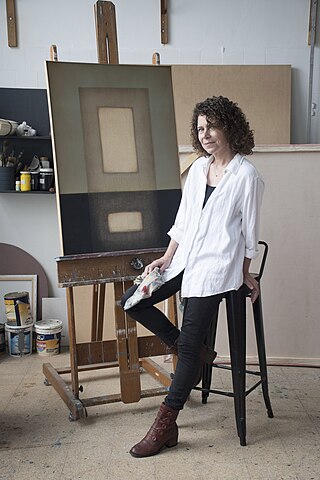Related Research Articles
Virginia Patrone is an Uruguayan visual artist who worked in Uruguay before moving to Spain in 2003.
Pablo Amancio Borges Delgado is a Cuban artist.
Roger Sebastián Aguilar Labrada is a Cuban artist specializing in graphic design, painting, drawing and engraving.

Lesbia Claudina Vent Dumois is a contemporary Cuban visual artist, whose works include illustration, painting, art curation, and engraving. She does not specialize in any themes but is "interested in the everyday and historical references."

Águeda Dicancro was a Uruguayan sculptor from Montevideo, noted for her plastic art. Her art is featured at the Museo Nacional de Artes Visuales in Montevideo.
María Freire was a Uruguayan painter, sculptor, and art critic. She was one of the leading figures in the development of concrete art and non-figurative art in Uruguay. She was a co-founder the Grupo de Arte No Figurativo.

Elvira Lacy Duarte Cardoso was a Uruguayan visual artist.

Amalia Nieto was a Uruguayan painter, engraver, and sculptor. She was a member of the Constructive Art Association led by Joaquín Torres-García and creator of her own style that stands out in Uruguayan art of the 20th century.
Amalia Polleri de Viana was a Uruguayan teacher, artist, poet, journalist, and art critic.

Eloísa Ibarra is a Uruguayan visual artist who has been recognized for her graphic works.

Cecilia Vignolo is a Uruguayan visual artist, teacher, and communicator.
Leonilda González was a Uruguayan painter and engraver, founder of the Montevideo Engraving Club. Her work is represented in the Juan Manuel Blanes Museum and the National Museum of Visual Arts, as well as in private collections in Uruguay and other countries. In 2006 she was recognized with the Figari Award for her career.

Nelbia Romero Cabrera was a Uruguayan visual artist. She began her career in drawing and engraving and later incorporated other artistic languages, such as photography, installation, and performance. Her work was marked by themes of politics and protest. She was an active participant in the Montevideo Engraving Club. She received a Guggenheim Fellowship in 1994 and was granted the Figari Award in 2006 for her artistic career.

Rimer Cardillo is a Uruguayan visual artist and engraver of extensive international experience who has lived in the United States since 1979.

Anhelo Hernández Ríos was a Uruguayan plastic artist and teacher.

Dumas Oroño was a Uruguayan artist, cultural manager, and teacher. His artistic work spanned several disciplines, including painting, engraving, ceramics, murals, and jewelry design.

Margaret Whyte is a Uruguayan visual artist.

María Ortega Gálvez is a Spanish artist specializing in painting, engraving, photography and textiles. She is director of the international association World Textile Art (WTA) and director of WTA's VIII International Biennial of Contemporary Textile Art, held in Madrid, Spain in 2019.

Alberto Nicasio was an Argentine artist (xylographer) and educator. He was a member of the Argentinian National Academy of Arts. A street in the city of Córdoba and a primary school in the province are named after him.
Marco Cárdenas is a Venezuelan engraver.
References
- 1 2 "Gladys Afamado: una cita sin fin" [Gladys Afamado: An Endless Appointment] (in Spanish). National Museum of Visual Arts . Retrieved 24 November 2017.
- ↑ Bandrymer, Sonia. "Arte Activo" (in Spanish). Ministry of Education and Culture of Uruguay. Retrieved 24 November 2017.
- ↑ Di Maggio, Nelson (2013). Artes Visuales en Uruguay: diccionario crítico[Visual Arts in Uruguay: Critical Dictionary] (in Spanish). Gussi Libros. ISBN 9789974991569.
- ↑ Frank, Patrick. "Grabados Uruguayos / Uruguayan Prints". Latin American Graphic Arts. Retrieved 24 November 2017.
- ↑ González, Leonilda (2006). Premio Figari 2006 (in Spanish). Central Bank of Uruguay. p. 42. Retrieved 24 November 2017– via Google Books.
- 1 2 "Curriculum Gladys Afamado" (in Spanish). Ministry of Transportation and Public Works of Uruguay. Archived from the original on 29 October 2013. Retrieved 24 November 2017.
- ↑ "Gladys Afamado será la homenajeada en el 60.º Premio Nacional de Artes Visuales". Ministerio de Educacion y Cultura. Retrieved 14 October 2022.
- ↑ "Afamado, Gladys". WorldCat . Retrieved 24 November 2017.